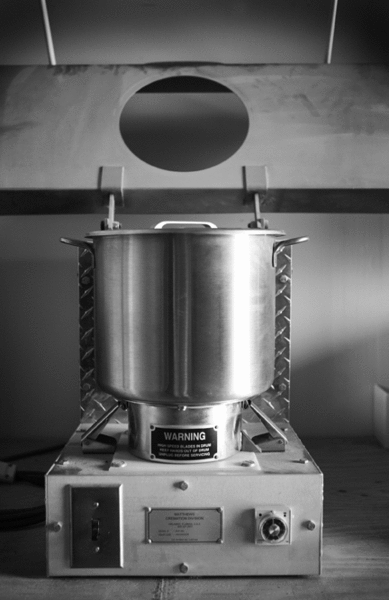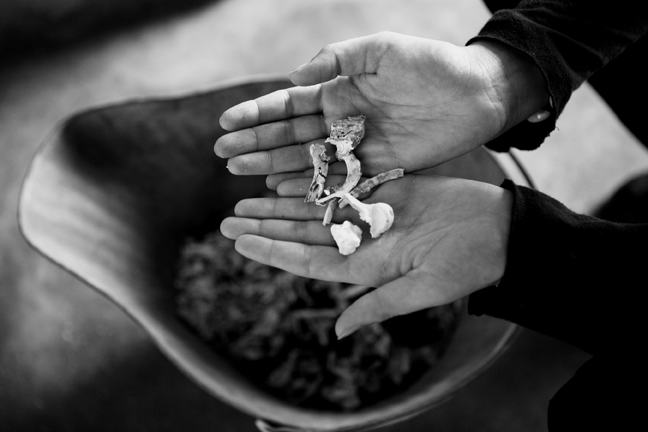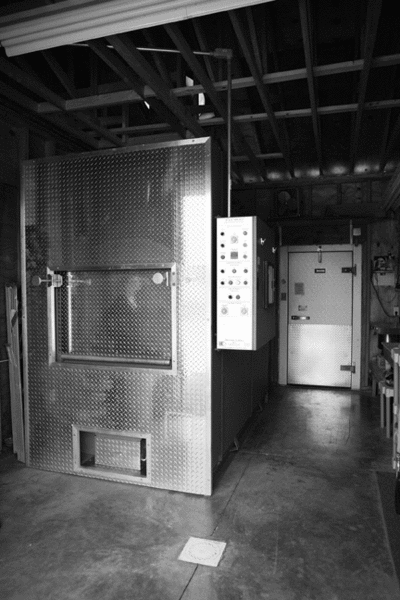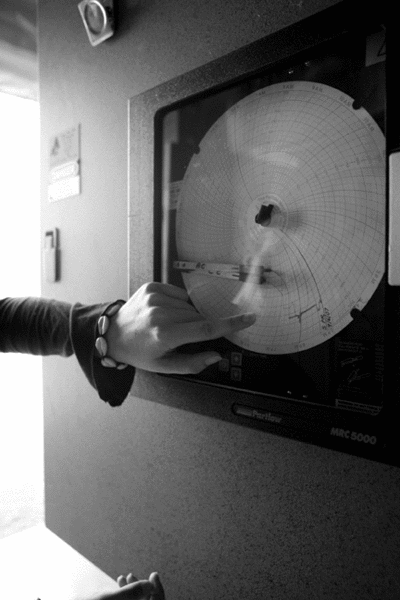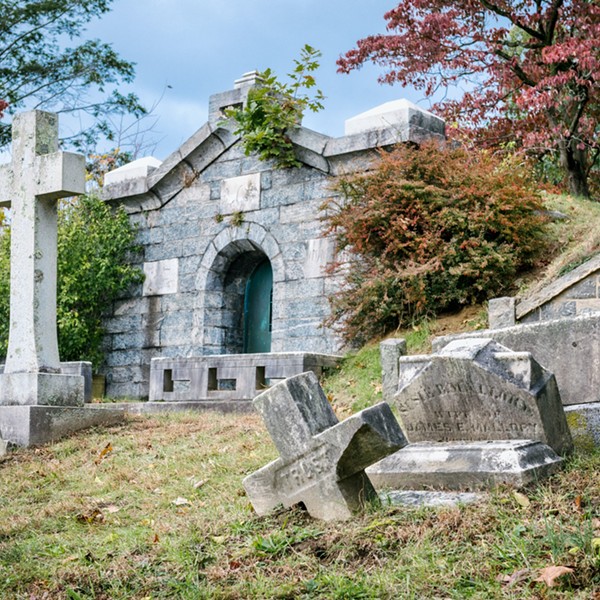Fitting to the emerging form of pet services, there is nothing funereal about Andrea’s appearance. In her early thirties and striking, with multiple ear piercings and elegant Sanskrit tattoos on both wrists, she looks far more like a stylish Pixies fan than a long-faced mortician. Nor does Buddy’s Place possess any of the squalid atmosphere of the dreaded knacker’s yard. Located in the rolling farmlands of central Columbia County, the crematorium is just minutes from both the Merchant and Ivory Foundation and the early 18th-century Luykas Van Alen house, which was used as a location for Martin Scorsese’s The Age of Innocence. The area has been likened to the pheasant-filled parklands of England before World War II, and while driving from Albany to Columbia County, I remember why this portion of the Hudson Valley has become the ideal spot for wealthy
urbanites wishing to fulfill fantasies of becoming landed gentry.
Andrea and I meet at a homemade-ice cream stand, unfortunately closed for Rosh Hashanah. Two of her pet dogs are snarfling around the backseat of her sedan, and she tells me that the bulldog named Sadie recently had surgery to implant a titanium kneecap. As I ponder the marvels of veterinary science, Andrea says she has to make a couple stops before we visit Buddy’s Place. Between the humane society, cruelty investigations, and the crematorium, she’s in constant motion, usually with live or dead animals in tow. Today she’s trying to finalize a cremation contract with a local veterinarian, and she makes sure to bring a box of doughnut holes, bagels, and a Buddy’s Place magnet as gifts for the office. Whether it’s aluminum siding, pharmaceuticals, or animal cremation contracts, sales is the same everywhere, and Andrea gets a partial victory when the receptionist tells her the vet will be sending cats to Buddy’s Place, though the dogs, which cost more because of their size and weight, will still go to another cremator, one who the doctor has been doing business with for years. Curious about the eternal feline-canine rivalry, I ask whether she gets more business from cat or dog people.
“It’s really about 50-50. If we get more dogs, it’s probably because we tend to get a lot of big dogs that the owners physically can’t move or bury by themselves.” The Walkers also have trouble with the bigger animals, and a third partner at Buddy’s Place, Ehren Melius—in his 20s, with Hunter Thompson’s “gonzo” symbol tattooed on a forearm—does the heaviest lifting.
From there, we make a short drive to the Columbia-Greene Humane Society shelter. The Hudson Valley is at its autumnal finest, with the air so clear that each yellowing leaf seems encased in glass. As we drive, Andrea tells me that I can compare the broken-down cremator at the shelter with the one she has at Buddy’s Place.
Set along a dirt road running between hay fields, the shelter, once a dairy farm, is a complex of small barns. The main office is surrounded by kennels, storage rooms, sick bays, and dog-walking areas, and a small pet cemetery beneath some pine trees. The office and cat rooms are cheery enough, but space limitations have forced the shelter to use several decrepit outbuildings as well. A couple of them are little more than grim concrete sheds, and it’s in one of these that the retired incinerator squats.
“Get ready to get creeped,” Andrea warns as we approach the former crematorium. Thick vines have grown over the main doorway and we have to squeeze down a mildewy passage between sheds to get to a side entrance. The dingy, unlit and unheated room is dominated by the massive incinerator. I gape at the
rusted-out machine, a hulking, square oven, until Andrea attracts my attention to an even more ominous sight: medical waste containers. “Burning medical waste is a big moneymaker for anyone with an incinerator,” she says. Columbia-Greene used to burn its own waste but now contracts with another incineration service. Andrea explains that many crematoriums, including human ones, burn medical waste. As unappealing as it is, medical waste earns up to $5 per small bag and can be a key source of income for shelters with their own incinerators. Few fi nd this aspect of the shelter business pleasant, and fewer still are willing to talk about it, but the economic incentive for taking in waste is often a matter of necessity for underfunded animal shelters. Desperately lacking in resources, shelters are forced to choose between refusing to accept more animals; overcrowding and the subsequent danger of disease; or euthanasia, all of which hit a nerve with a pet-obsessed public.
GRIM PASSAGE
“Cremations used to be the rite of passage for new staffers,” Andrea tells me as we walk around the machine. “We were all in our early 20s, so, you know, we thought we were badasses. In winter, we’d lean against the incinerator and smoke cigarettes while it was running to freak new people out.
“You definitely need a sense of humor for this,” she adds, and Andrea has that in abundance. Returning a follow-up call later in the week, she hoots over her cell, “Guess what we’ve got in the van now?” It turns out to be a 115-pound Newfoundland that had been euthanized for aggressive behavior, then exhumed from the owner’s yard and decapitated in order to check the brain tissue for rabies. If that seems grisly, Andrea’s duties as cruelty investigator defy the limits of tolerance. Frequently called out to investigate country squalor at its worst, she relates incidents of sickening routine: starved farm animals, unwanted kittens roasted alive in a burn barrel, or cancerous dogs frozen to the winter ground by their own burst tumors.Not so routine is a recent call to Germantown, where a senile woman in her 90s was removed from a house where dozens upon dozens of handmade coffins filled with dead cats were discovered beneath the knee-high layers of filth, feces, and other cat corpses. The oven’s menace seems to pale in comparison to stories like these, until we look inside.
The incinerator door has been rusted shut, and we have to slam the squealing handles open. The inner brick lining inside has crumbled to dust, and a hole gapes in the center of the floor directly where most of the copses would lie. Looming in the far back are the rib bones of a small animal. Rags of scorched fur still cling to the skeleton.
“We couldn’t finish the cremation because the flooring collapsed,” Andrea informs me with a depressed sigh. “Now there’s no way anyone can get it out. One time, there was a malfunction and a burning body fell through the back of the incinerator into the inner machinery. That could have set the whole incinerator on fire so one of us, a girl, waited until everything was cooled down, then crawled inside the oven and got the body. That really took courage.”
Along with liability and staff safety issues, dangers such as fires and biohazards are why Columbia-Greene retired the oven and now outsources its cremations, yet another strain on a depleted budget that can neither afford to replace the incinerator or have it dismantled and removed by an expert.
Blinking against the mellow September sun, a white dog in an open enclosure silently watches us when we emerge from the passageway. Th e dog is as placid as the chopped fields and brushy hillsides that surround the shelter. Thankful to be among the living again, we’re off to Buddy’s Place.
Inside, Buddy’s Place is divided in half, with an office on one side and the incinerator and walk-in freezer for cadavers on the other. Smelling lightly of nag champa incense, with a futon couch and glass-fronted woodstove along the wall, the office also doubles as display area for urns and other containers for “cremains,” as the ashes are referred to. Customers are able to select from among the tin canisters of varying sizes and designs, hefty brass urns, granite headstones, and handcrafted, locally made, wooden boxes. The cremains are given to clients in the container of their choice, along with a satin drawstring bag imprinted with “forget-me-not,” a freshly cut bouquet of flowers, and, if the owners have requested, a hardened clay pawprint of the deceased. It’s also common that flowers be placed alongside the pet inside the incinerator if the owner is present for the cremation. As Andrea will emphasize throughout the day, whether the deceased is human or not, providing dignity and ritual to death is important to the bereavement process. From the pictures of pets and thankful letters sent by past clients, it’s obvious the Walkers’ efforts are appreciated. Anyone believing such consideration in the pet funeral industry is typical, however, would be sadly disappointed.
When Karen Walker’s aged basset hound, Buddy, was euthanized at home in the mid-’90s, she asked the attending vet to have the body cremated so she could scatter the ashes. Like most veterinary clinics, this one outsourced cremations to incineration specialists, and, in Buddy’s case, the specialist was named Terence McGlashan. With his silken manners and impeccable suits, McGlashan appeared every inch the professional mortician, but instead of cremating the cadavers, he paid a dairy farmer to dump them in a pit not far from Saratoga Springs. The unsuspecting pet owners were given ordinary wood ashes, though anyone who’s ever seen human or pet cremains would know that no matter how finely sifted, a few tiny shards of bone are always present. When the police discovered the pit after a passing jogger complained of the smell, more than 40,000 animal corpses from three different states were exhumed from the reeking pasture. Adding to the horror was McGlashan’s sideline: medical waste incineration. Internal organs, surgically removed tumors, and hypodermic needles were strewn throughout the pit. The police and the state wildlife pathologist sorted through the corpses’ identifying tags in order to inform as many of McGlashan’s clients as possible what had happened to their pets, and McGlashan eventually served a six-month sentence for fraud. But that was little consolation to the Walkers, who were inspired to create a pet crematorium and funeral service that provided everything they’d been denied by McGlashan: the clean, respectful, and dignified service any beloved companion deserves. This
For better or worse, Karen tells me, this day’s cremation will be a messy one. It’s a 14-year-old golden retriever that’s died of natural causes. The elderly owner had trouble with the body, though, and the retriever had been stuck in the furnacelike trunk of his car for a full day before a vet performed an autopsy and turned the corpse over to the Walkers.
What’s amazing about the Walkers, however, is that they haven’t surrendered to that numbness. The retriever is laid on a tarp on top of a raised stretcher, and Karen is right, this one is disgusting. The body reeks, the autopsy sutures are bursting, and maggots squirm everywhere, but still, time is taken to press the paw twice into the clay so the owner gets a clear print before the corpse is carefully rolled into the oven. Visibly horrified by the larvae, Andrea is bleaching the floor the moment the oven door closes, and whether it’s Andrea shuddering at the maggots or Karen hauling the fetid tarp out into the sun, it’s plain that what these women do isn’t easy for them but they do it because they believe the grieving owners and their deceased animals deserve their care. Not an easy accomplishment when the messiest details of death are a workaday reality.
Wanting some space, I go around back to check the chimney. There’s no smoke or smell whatsoever, just a plume of heat emanating from the top of the stack, and any thoughts that animals might avoid the funereal location turn out to be nothing more than superstitious fabrications. Birds fly nearby, monarch butterflies bounce among the red blossoms, and neighboring dogs stroll the fence line, their only obvious concern being my presence near their turf.
The afternoon doesn’t hit home until I’m driving back to Albany. Imagined or not, I can’t get the smell of the maggots out of my sweater. There’s no way to avoid brooding on morbid churchyard images and I picture what I’ll write on my cat’s headstone when the time comes: He Was My Friend. What’s compelling about the Walkers is that they treat every animal as if it were a close companion. Not even the bones at the back of the shelter’s incinerator are forgotten, and Andrea tells me that she plans on cremating those and spreading the ashes when the oven is finally taken out. Wanting it as much for herself and the memory of Buddy as for the abandoned creature and the good of the shelter, she says, quietly, “At least that’ll be some kind of completion.”







